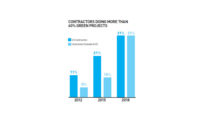A new report from the U.S. Green Building Council highlights more than 30 existing federal programs worth $72 billion that could enhance efficiency in commercial buildings and multifamily housing.
Released on April 29, the report concludes the federal government is not fully taking advantage of the opportunities presented by the programs. The report authors note that, as of 2009, green buildings represented only 2% of new residential and commercial construction in the United States.
USGBC officials speaking at a panel discussion in Washington, D.C., said they hoped to use the document as a tool to educate policy-makers and building industry leaders about the opportunities presented by the variety of programs already on the books.
Some of the most promising op- tions identified by the report authors include integrating energy-efficiency and sustainability criteria into competitive grants and funding formulas; refining guidance applicable to the energy-efficient commercial-buildings tax deduction and the national historic-preservation tax credit and the federal banking “greening” regulation.
The report also identifies several barriers that have prevented green building practices from becoming more widespread. A key challenge, said panelist Ashok Gupta, director of energy policy and a senior energy economist at the Natural Resources Defense Council, will be making sure “people take advantage of the authority that they already have.” Some agencies, he said, have been slow to implement the programs.
“This report can be a continuous source of guidance over the years,” said Roger Platt, USGBC’s senior vice president of global policy and law.




